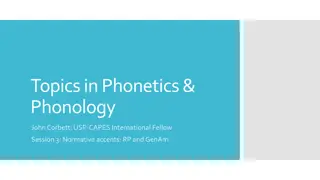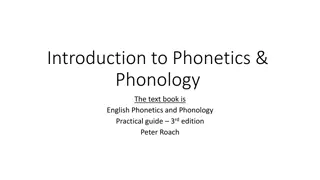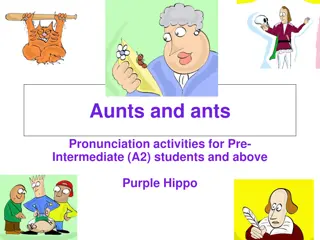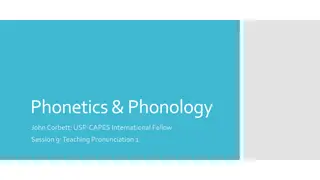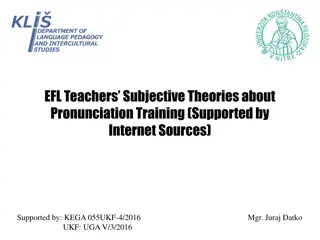Insights on English Pronunciation Variations and Intelligibility in Language Teaching
Dive into the nuances of vowel articulations and consonant recommendations in English pronunciation. Explore the concept of Lingua Franca Core vowels and how variations among L1 English speakers impact intelligibility. Understand the importance of mutual intelligibility in non-native speaker communication and the role it plays in language learning and teaching strategies.
Download Presentation

Please find below an Image/Link to download the presentation.
The content on the website is provided AS IS for your information and personal use only. It may not be sold, licensed, or shared on other websites without obtaining consent from the author.If you encounter any issues during the download, it is possible that the publisher has removed the file from their server.
You are allowed to download the files provided on this website for personal or commercial use, subject to the condition that they are used lawfully. All files are the property of their respective owners.
The content on the website is provided AS IS for your information and personal use only. It may not be sold, licensed, or shared on other websites without obtaining consent from the author.
E N D
Presentation Transcript
Phonetics & Phonology John Corbett: USP-CAPES International Fellow Session 12: English as a Lingua Franca 2: Vowels
This session: What are the LFC vowels, and what position does ELF take on vowel length? Is intelligibility all there is to pronunciation learning and teaching? Today s session
Focus on mutual intelligibility among non-native speakers as the goal of teaching and curriculum design Review: What is ELF? Uses empirical data to determine which sounds cause problems of intelligibility which sounds are at the root of communication breakdown?
Summary of LFC recommendations on consonants: Allow substitutions for / / and / / Allow substitutions for dark [ ] Encourage the use of GenAm [ ] and a rhoticaccent Avoid the alveolar flap [ ] in place of intervocalic [t] Encourage aspirated initial voiceless plosives [p ], [t ] and [k ] Train learners to shorten vowels before voiceless/fortisconsonants, so the first vowel is slightly shorter in the minimal pairs /p k/ and /p g/ or /si:t/ and /si:d/. Additional unstressed vowels in consonant clusters don t usually cause intelligibility problems, so don t worry about them. You can say /w k d/ Insist on full consonant clusters at the beginnings of words. Some Asian learners say [ p d k] for <product> and that causes problems. Allow simplification by deletion, especially of /t/ and /d/, in the middle and ends of words, as this is a general feature of L1 RP and GenAmtoo, e.g. you can delete the medial /t/ in <fact-sheet> and the /d/ in <friendship>. Pronounce the final /t, d/ when they are past-tense markers. Follow RP in NOT reducing clusters with intervocalic /nt/ to /n/ in words like <international> or <twenty>. Americans often do elide here but it can cause problems with spelling-pronunciation correspondences. Review: LFC consonants
In the English-speaking world (as we have seen) there is a variation in the quality and quantity of vowel articulations in particular words. L1 English speakers are consistent in their own articulations, but there is variation among groups of speakers. Lingua Franca Core (LFC): Vowels How do you (and different L1 English speakers) pronounce <dog>?
<dog> can be pronounced: /d / RP /d g/ GenAm /d / Scots Lingua Franca Core (LFC): Vowels The variation in quality (tongue and lip position) does not seem to cause serious intelligibility problems. So why should L2 speakers worry? They might even pronounce it /d g/.
The variation in quality (tongue and lip position) of vowels does not seem to cause serious L2-L2 speaker intelligibility problems. Sometimes quantity (duration of production) can cause problems, Lingua Franca Core (LFC): Vowels So The LFC position is that Quality of vowel articulation is not an issue if the L2 speaker maintains consistency Focus should be put on vowel quantity, particularly for diphthongs So is this what you should be doing? http://youtu.be/i9K3NCMpDO8
The LFC [] eschews considerations of diphthong quality, with the proviso that whatever quality is used, the length must be that of a diphthong or long vowel, and the variant must be used consistently. Jenkins 2000: 145 Lingua Franca Core (LFC): Vowels Conclusion it doesn t matter if you are Henry Higgins or Eliza Doolittle but you shouldn t switch between one and the other.
An exception: The long open mid-central vowel / :/ is unusual in non-English phonemic systems and it is the least common English monophthong, occurring mainly before /r/ in words like <bird>, <worth> in non-rhoticaccents. Lingua Franca Core (LFC): Vowels Some learners substitute / :/ but that has been shown to cause intelligibility problems, e.g. <curtain> was confused with <carton> LFC recommends that / :/ is taught.
Weak forms those mainly grammatical words in unstressed positions in the sentence can cause intelligibility issues even when they are pronounced by L1 English speakers. The vast majority of learners, including many who become fluent bilinguals, use few weak forms other than a and the . In this sense, despite the fact that it is easy to formulate clear rules for weak form use, they are unteachable. Jenkins 2000: 147 (emphasis added) Lingua Franca Core: Weak forms LFC recommendations: (1) strong version: encourage full forms for production but teach weak forms for reception. (2) weak version (for L2 teachers): don t worry about teaching unstressed / /, but shorten the vowel, while retaining its quality. So Don t change /w :z/ to /w z/ Change /w :z/ to /w z/
L1 speakers and fluent L2 speakers have a speed of about 350 syllables a minute. Therefore elision, assimilation and linking/intrusive features appear. Other L2 speakers will be slower. Teaching these processes for slower speech will affect intelligibility and it will not help learners speed up. Other features of connected speech LFC recommendation: Do NOT teach assimilation, elision or linking features, e.g. /grim p n/ As they get faster, learners will acquire these processes naturally. Again, like weak forms, you might wish to point them out for listening/reception purposes.
English and Continental Portuguese are said to be stress-timed. Brazilian Portuguese and Spanish are said to be syllable-timed. These descriptions are based on idealised articulations, often of nursery rhymes. The distinction has been challenged, and even dismissed as a myth (Jenkins 2000: 149) Rhythm LFC recommendation: forget stress-timing, and forget jazz chants (unless you want to have fun drills). Focus on the lengthening of stressed (nuclear) syllables in word groups.
Word stress itself rarely causes intelligibility issues. Word stress rules are complex and unteachable. BUT Misplaced stress affects the aspiration of initial voiceless plosives, which occur in initially stressed syllables, and these are important for intelligibility Word stress SO LFC recommendation: give some simplified guidance, eg Most 2-syllable nouns receive stress on the first syllable Most 2-syllable verbs receive stress on the second syllable Certain suffixes like <-ese> are stressed unless the word is a modifier, eg She s ChiNESE , but She s a CHInese student. Let the learners know that there are many exceptions
A short video interview with Jennifer Jenkins: http://www.youtube.com/watch?v=Gp96u8UzvV4 Summing up LFC recommendations challenge many traditional teaching assumptions and practices. They are therefore controversial. What are your thoughts about them?
What do we do now? Adapting pronunciation teaching for the Brazilian classroom in the ELF era How do you correct students when they have choices!? Is intelligibility all there is? Next week




